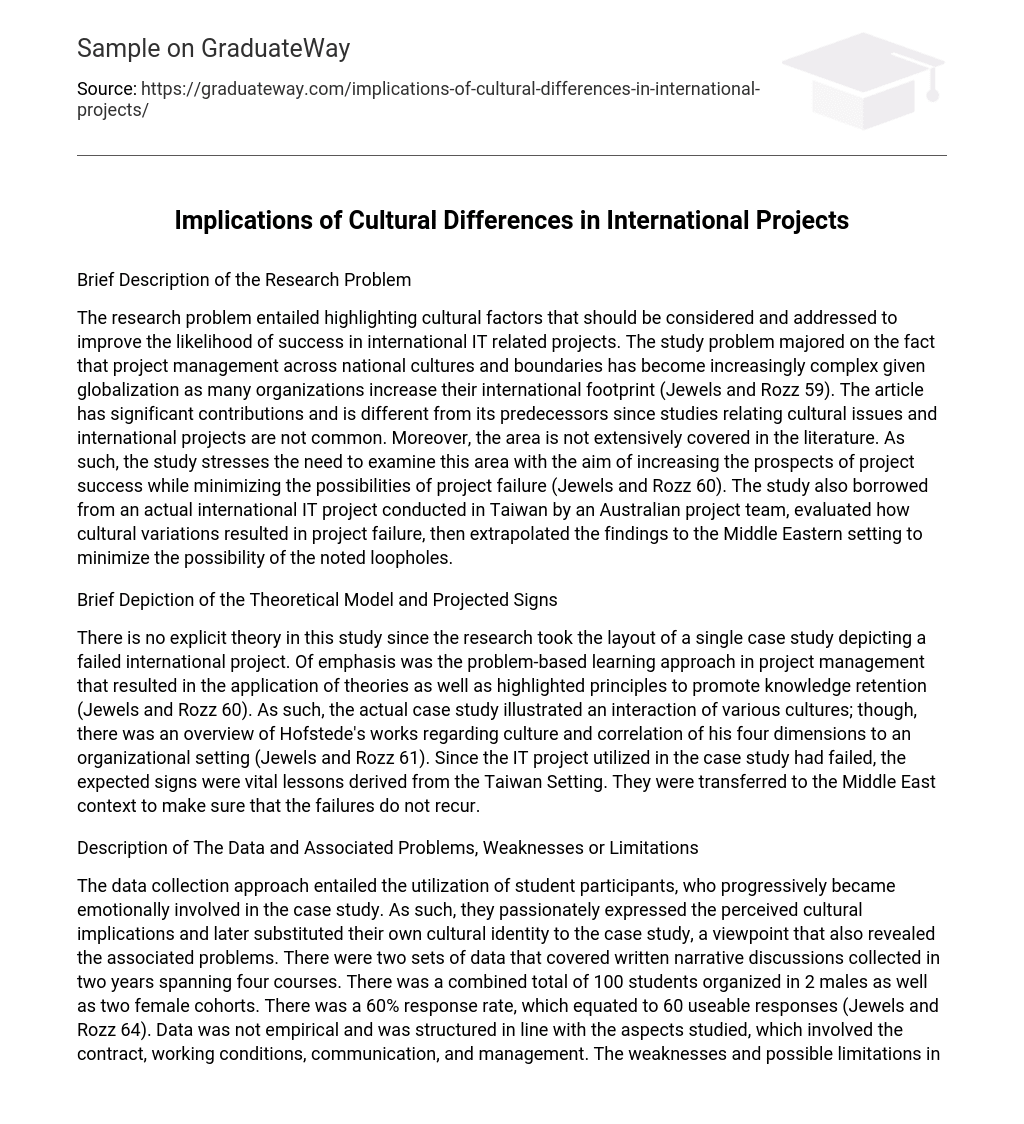Brief Description of the Research Problem
The research problem entailed highlighting cultural factors that should be considered and addressed to improve the likelihood of success in international IT related projects. The study problem majored on the fact that project management across national cultures and boundaries has become increasingly complex given globalization as many organizations increase their international footprint (Jewels and Rozz 59). The article has significant contributions and is different from its predecessors since studies relating cultural issues and international projects are not common. Moreover, the area is not extensively covered in the literature. As such, the study stresses the need to examine this area with the aim of increasing the prospects of project success while minimizing the possibilities of project failure (Jewels and Rozz 60). The study also borrowed from an actual international IT project conducted in Taiwan by an Australian project team, evaluated how cultural variations resulted in project failure, then extrapolated the findings to the Middle Eastern setting to minimize the possibility of the noted loopholes.
Brief Depiction of the Theoretical Model and Projected Signs
There is no explicit theory in this study since the research took the layout of a single case study depicting a failed international project. Of emphasis was the problem-based learning approach in project management that resulted in the application of theories as well as highlighted principles to promote knowledge retention (Jewels and Rozz 60). As such, the actual case study illustrated an interaction of various cultures; though, there was an overview of Hofstede’s works regarding culture and correlation of his four dimensions to an organizational setting (Jewels and Rozz 61). Since the IT project utilized in the case study had failed, the expected signs were vital lessons derived from the Taiwan Setting. They were transferred to the Middle East context to make sure that the failures do not recur.
Description of The Data and Associated Problems, Weaknesses or Limitations
The data collection approach entailed the utilization of student participants, who progressively became emotionally involved in the case study. As such, they passionately expressed the perceived cultural implications and later substituted their own cultural identity to the case study, a viewpoint that also revealed the associated problems. There were two sets of data that covered written narrative discussions collected in two years spanning four courses. There was a combined total of 100 students organized in 2 males as well as two female cohorts. There was a 60% response rate, which equated to 60 useable responses (Jewels and Rozz 64). Data was not empirical and was structured in line with the aspects studied, which involved the contract, working conditions, communication, and management. The weaknesses and possible limitations include the fact that it was not easy to quantify the responses or subject them to statistical tests. Besides, the students used as study participants had not previously worked in an international IT project setting.
A Description of the Results, and Problems in Interpretation
Regarding the contract, the respondents affirmed that contractual arrangements were differently interpreted between the Taiwanese and the Middle Eastern cultures. They noted differences in contract meaning between the Chinese as well as the Australian contract teams. Insufficient information was pointed out regarding the project scope. Concerning the working conditions, the participants singled out that the Australian project team members were accustomed to working seven days a week for over 100 hours (Jewels and Rozz 64).
The Taiwanese work ethic was similarly strong, averaging 12 to 15 hours daily. An overview of communication outcomes showed that the team members were reluctant to communicate with one another. They avoided informal communications by separating both lunch and tea breaks, yet there was no significant evidence of the language barrier. Regarding management, the student participants noted that decision-making was a critical difference between the Australian as well as Taiwanese clients. Problems in the interpretation were apparent considering that there was no uniformity in decision-making. Moreover, there were no measures in place to foster effective communication that entailed giving regular feedback on project progress (Jewels and Rozz). Proactive actions were not taken to harmonize the understanding of the contract, resulting in a flawed interpretation highlighting the lack of coordination to promote teamwork needed to achieve shared study goals.
Overall Conclusion Regarding the Study Accounting for Data Problems, Modeling Problems, and Problems in Interpretation
The conclusions reached by the scholars are supported by the research study. Notably, they underscore the understanding of culture in the context of international project management to account for data, modeling, and interpretation problems. Regarding data problems, there were distinct themes that evolved from the overall student responses factoring the local culture. The narrative descriptions used to model the responses were accounted for in the discussion section. Content analysis was used to provide an elaborate interpretation entailed an appraisal of the case highlighting the Australian/Taiwanese example to emphasize how cultural differences might ultimately affect the overall project success (Jewels and Rozz 68) As such, the conclusion is precise and supported by research, resulting in a comprehensive study that addressed the study objectives. The examples used formed a solid basis for comprehension of cultural variations in international IT projects to encourage the adoption of strategies likely to minimize differences that may hinder successful completion.
Work Cited
- Jewels, Tony, and Rozz Albon. ‘Implications of Cultural Differences in International Projects.’ International Journal of Information Technology Project Management (IJITPM), vol. 4, no. 1, 2013, pp. 58-71.





